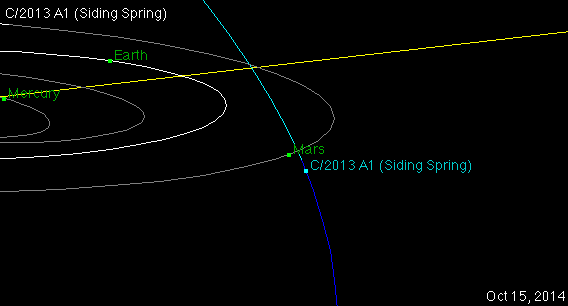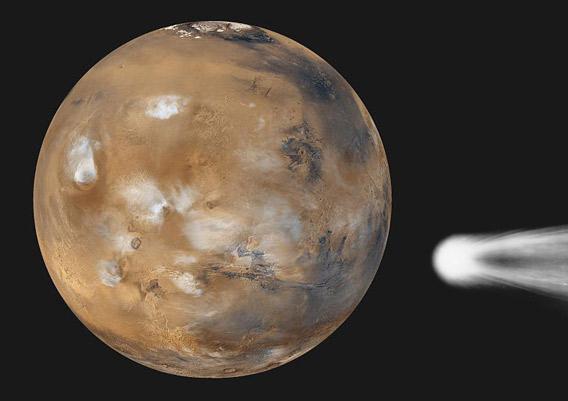A few weeks back I reported that there was a small chance a comet might hit Mars in October of 2014. Since that time further observations of the comet have tightened the calculation of its orbit, and it now looks like it will miss the red planet, by a little over 110,000 kilometers (68,000 miles).
I have to admit I’m a little conflicted about this. I’d hate to see us lose any of our hardware on or in orbit around Mars, but a comet impact on another planet would be an amazing thing to see, and be a huge benefit to science.
The comet is called C/2013 A1 (Siding Spring). It was discovered early in 2013, and it was quickly determined it would have a close pass of Mars in 2014. It wasn’t clear just how close it would get, and there was a small chance it might physically impact Mars. We hadn’t been observing it long enough to determine an accurate enough orbit (I explain how that works in another post).
However, follow-up observations have improved the accuracy of the orbit. It’ll be a close pass, but the odds of an actual impact have dropped significantly; Space Fellowship reports they are now less than one in 100,000.

Image credit: NASA/JPL
However, that’s not the end of the story. Comets are similar to asteroids in that they are large (several kilometer diameter) objects made up of rock, but comets also contain a lot of ice: frozen water, ammonia, carbon dioxide, and so on. As they near the Sun this ice turns into a gas and expands (called the coma) around the solid part (called the nucleus). The coma can be well over 100,000 km across, so it’s possible Mars may pass through it.
Moreover, the ice in the comet will have lots of dust and gravel embedded in it. This is let loose when the ice turns into a gas, so it’s still possible Mars will get pelted by this material. The gas and gravel may still constitute a real problem for the handful of spacecraft orbiting Mars. At the speed of this comet relative to Mars (roughly 50 km per second, or over 100,000 miles per hour), even a grain of sand can wipe out a spacecraft.
Hopefully the coma of Siding Spring won’t be too big or have too much debris in it. I’d hate to see any of our probes damaged by this. I’ll add that we are in no danger whatsoever on Earth. The comet doesn’t get anywhere near us.
So at the moment Mars looks like it’ll get a close brush, but be spared an actual impact. In the meantime, we might get a great show, but from another comet: C/2012 S1 (ISON), which may still get quite bright in a few months time. We’re still not sure, but I’m hoping. Comets are lovely to see, especially when they don’t hit planets.
Tip o’ the Whipple Shield to Mycroft16 on Twitter.
